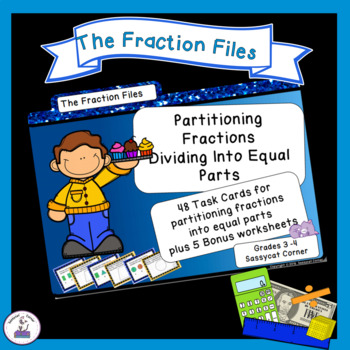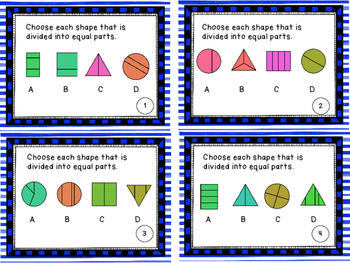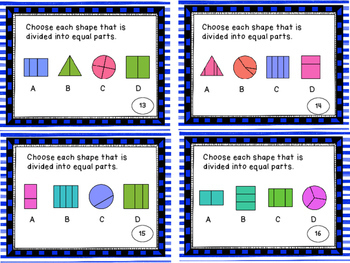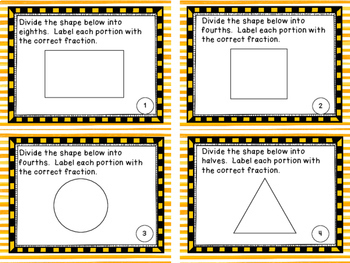Identify Fractions by Partitioning Unit Fractions Task Cards
Sassycat Educational Resources
3.3k Followers
Grade Levels
2nd - 5th, Homeschool
Subjects
Standards
CCSS3.NF.A.1
CCSS4.NF.A.1
Formats Included
- PDF
Pages
31 pages
Sassycat Educational Resources
3.3k Followers
Also included in
- Are your students working on learning to identify fractions? This is an IMPORTANT first step in working with fractions of any kind. This set of task cards includes SIX different sets of cards (several double sets of 68 to 72 cards) that allow students to identify fractions by naming equal parts, pPrice $18.20Original Price $26.00Save $7.80
Description
Partitioning fractions to create unit fractions are a great way to build a conceptual understanding of fractions. This is a great addition to your fraction files! This set of 48 fraction task cards will help you reinforce the concept of partitioning fractions into equal pieces to make unit fractions. Works well with any fractions unit, but also works with Grade 3, Module 5, Eureka Math / Engage NY Math.
Whether your looking for a beginning activity to introduce the concept; a mid unit review, take it to your seat center; workstation, whole class game for Scoot or Jeopardy; or end of the unit test review, this set of task cards will make your lesson pop.
Included with this set of task cards are 5 bonus worksheet for extra practice with this skill set.
Find more fraction activities by searching my store - Sassycat Corner.
Whether your looking for a beginning activity to introduce the concept; a mid unit review, take it to your seat center; workstation, whole class game for Scoot or Jeopardy; or end of the unit test review, this set of task cards will make your lesson pop.
Included with this set of task cards are 5 bonus worksheet for extra practice with this skill set.
Find more fraction activities by searching my store - Sassycat Corner.
Total Pages
31 pages
Answer Key
N/A
Teaching Duration
N/A
Report this resource to TPT
Reported resources will be reviewed by our team. Report this resource to let us know if this resource violates TPT’s content guidelines.
Standards
to see state-specific standards (only available in the US).
CCSS3.NF.A.1
Understand a fraction 1/𝘣 as the quantity formed by 1 part when a whole is partitioned into 𝘣 equal parts; understand a fraction 𝘢/𝑏 as the quantity formed by 𝘢 parts of size 1/𝘣.
CCSS4.NF.A.1
Explain why a fraction 𝘢/𝘣 is equivalent to a fraction (𝘯 × 𝘢)/(𝘯 × 𝘣) by using visual fraction models, with attention to how the number and size of the parts differ even though the two fractions themselves are the same size. Use this principle to recognize and generate equivalent fractions.






